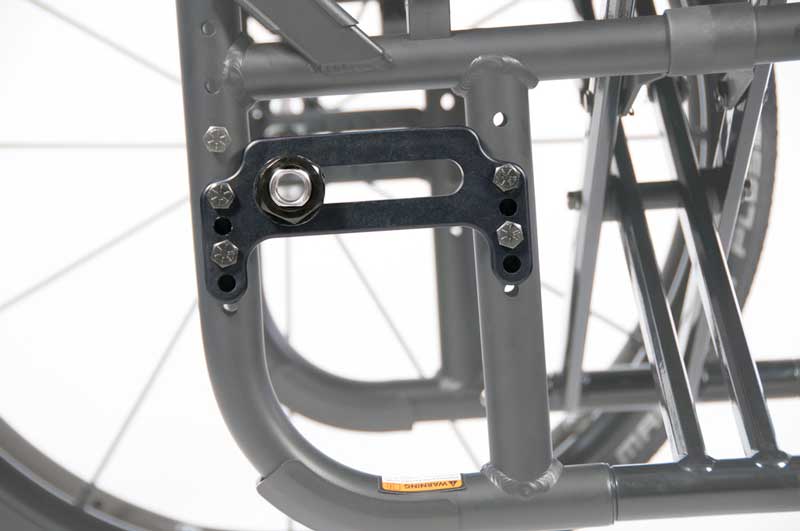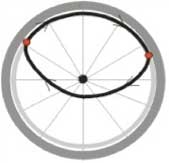When recommending a K0005 manual wheelchair, it is likely that the recommendation is in part due to the weight of the wheelchair as implied by the name, "Ultra Lightweight Manual Wheelchair." RESNA defines an Ultra Lightweight Manual Wheelchair (ULWC) as "a fully modifiable (adjustable and/or configurable) wheelchair that is as light as possible, is designed as an individual's primary mobility device and does not include such features as tilt or recline."
However, Medicare defines an ultra lightweight wheelchair (K0005) as a wheelchair that weighs less than 30 pounds and has an adjustable rear axle. For Medicare to cover an ultra lightweight wheelchair, the beneficiary must be a full-time manual wheelchair user and must require individualized fitting and adjustments for one or more features such as, but not limited to, axle configuration, wheel camber, or seat and back angles, and which cannot be accommodated by a K0001 through K0004 manual wheelchair.
Additional conditions of coverage include that the beneficiary must have a specialty evaluation performed by a licensed/certified medical professional (LCMP), such as a PT or OT, or physician who has specific training and experience in rehabilitation wheelchair evaluations (with no financial relationship with the supplier). Also, the wheelchair must be provided by a Rehabilitative Technology Supplier (RTS) that employs a RESNA-certified Assistive Technology Professional (ATP) who specializes in wheelchairs and who has direct, in-person involvement in the wheelchair selection for the patient.

An ultra lightweight manual wheelchair provides the ability to individually configure many aspects of the wheelchair in order to match the specific needs of the individual user. These adjustments may include axle configuration, wheel camber, seat & back angles, front frame angles, and more. Moreover, many of the wheelchairs in this category can be modified or adjusted over time to meet the changing needs and capabilities of the user.
Axle Adjustments
One of the most frustrating situations for a seating and mobility therapist is to see an active manual propeller reaching back for their rear wheel because the center of gravity setting is in the most rearward position. All ultra lightweight manual wheelchairs allow for center of gravity adjustments. This is accomplished by moving the rear axle forward or backward along the axle plate. The clinical recommendation for active users is to adjust the rear axle as far forward as possible without compromising the stability of the user. This adjustment decreases the rolling resistance, increases the propulsion efficiency, and improves the amount of hand rim used by the individual, among many other benefits proven over the years. The axle can also be moved vertically for optimal reach on the wheel's handrim.

Optimal configuration of the rear axle is when the tip of the middle finger is at the wheel hub and the user has 100-120° of elbow extension at the top of the pushrim. We also look for good lateral spacing. The goal is to have a good, long stroke pattern when self-propelling. Even with minimal forward movement of the rear wheel, end-users experience less work to propel their chair, find it easier to overcome thresholds & obstacles, reduce stress on their upper extremity muscles, and we also see better sitting positions in their chair. This position also allows for better alignment of the hand over the rear wheel and helps generate proper hand placement on the rear wheel during propulsion. This will allow the user to complete a 10-2 push (imagine the rear wheel as a clock).

Arc

Semi-circular

Double Loop

Single Loop
In addition to horizontal, vertical, and lateral adjustments, the ATP should adjust wheel camber. Wheel camber is angling of the wheels so that the tops of the wheels are brought closer together and the bottoms of the wheels are moved further out. It is measured in degrees. The wheel camber allows for increased stability of the wheelchair, changes in the overall center of gravity, overall width of the chair, and can change the overall seat-to-floor height. We often see wheel camber used for individuals playing sports to protect their hands during propulsion. However, wheel camber is another adjustment that is often forgotten about during the delivery/adjustment process.
Horizontal position affects:
- Wheel access/UE position
- Maneuverability
- Center-of-gravity/stability
Vertical position affects:
- Wheel access/UE position
- Seat-to-floor height
- Orientation in space
Lateral position affects:
- Wheel access/UE position
- Overall width
Camber affects:
- Wheel access/UE position
- Maneuverability
- Stability
There are best practice guidelines that assist in the evaluation for wheeled mobility and seating. In order for a wheelchair to meet the established goals, it is important to ensure that the wheelchair is setup in the most optimal configuration. The adjustability and configurability of this wheelchair technology is key to appropriate provision and ensuring the best outcome and user satisfaction. Often the "complex" part of the process must continue throughout the lifetime of the wheelchair's use.
References
- Boninger, M. L., Baldwin, M., Cooper, R. A., Koontz, A., & Chan, L. (2000). Manual wheelchair pushrim biomechanics and axle position. Archives of Physical Medicine and Rehabilitation, 81(5), 608-613. doi:10.1016/s0003-9993(00)90043-1
- Digiovine, C., Rosen, L., Berner, T., Beltz, K., Roesler, T., & Schmeler, M. (2012). RESNA Position on the application of ultralight manual wheelchairs. RESNA. resna.org
- Preservation of upper limb function following spinal cord injury: A clinical practice guideline for healthcare professionals. (2005). Washington, D.C.: Consortium for Spinal Cord Medicine. https://pva-cdnendpoint.azureedge.net